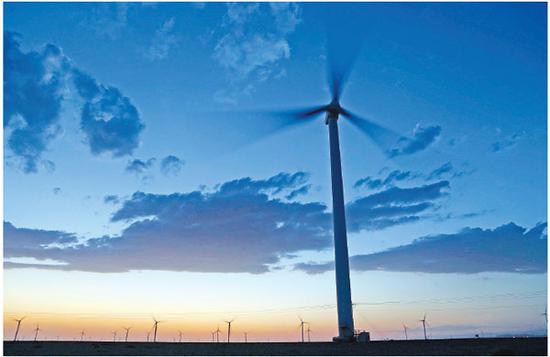
A wind turbine system generates energy in the Xinjiang Uygur autonomous region. (Photo/Xinhua)
China may have reached a key emissions target outlined in the UN Paris climate agreement more than a decade ahead of schedule, according to a new study by researchers in the United Kingdom.
In 2015, China pledged to peak its carbon dioxide emissions by 2030. However, a team of climate scientists from the University of East Anglia, Cambridge University and University College London has found that emissions in China peaked in 2013 and declined each year between 2014 and 2016, which was the time period studied.
"As the world's top emitting and manufacturing nation, this reversal is cause for cautious optimism among those seeking to stabilize the Earth's climate," said Guan Dabo, a professor of climate change economics at the University of East Anglia, who led the study. "Now, the important question is whether the decline in Chinese emissions will persist."
China committed to reducing emissions along with more than 50 nations as part of a major climate deal known as the Paris climate agreement, which was ratified by the United Nations Framework Convention on Climate Change in 2016.
The new study, published in the journal Nature, found that Chinese emissions peaked at 9.5 gigatons of carbon dioxide in 2013, and then declined by 4.2 percent during the three years that followed.
Researchers attribute the reduction in emissions to changes in industrial structure and a decline in the share of coal used for energy. Decreasing energy and emissions intensity also contributed to the decline.
"We conclude that the decline of Chinese emissions is structural and is likely to be sustained if the growing industrial and energy system transitions continue," Guan said. "Government policies are also a sign that the decline in China's emissions will carry on."
China recently took the decision to cap coal usage at 4 billion metric tons a year, meaning the proportion of coal in the nation's energy mix is on course to decrease from 64 percent in 2015 to 58 percent by 2020.
Coal is an abundant and relatively inexpensive energy source. However, the fossil fuel is a leading cause of emissions that cause air pollution in many nations around the world, and the Paris agreement called on participating nations to reduce reliance on coal-burning factories.
"In response to the US withdrawal from the Paris agreement, China has increasingly assumed a leadership role in climate change mitigation, and its five-year progress reports under the agreement will be heavily scrutinized by the rest of the world," Guan said.
While he said the study is cause for optimism, he warned that China's emissions may fluctuate in the coming years and 2013 may not represent the "final peak".
Preliminary figures for 2017 indicate a possible increase in emissions, while a separate analysis from Greenpeace found that emissions increased by 4 percent in the first quarter of 2018. But changes in industrial activities, coal use and efficiency are rooted in the changing structure of China's economy and long-term government policies, Guan said.


















































